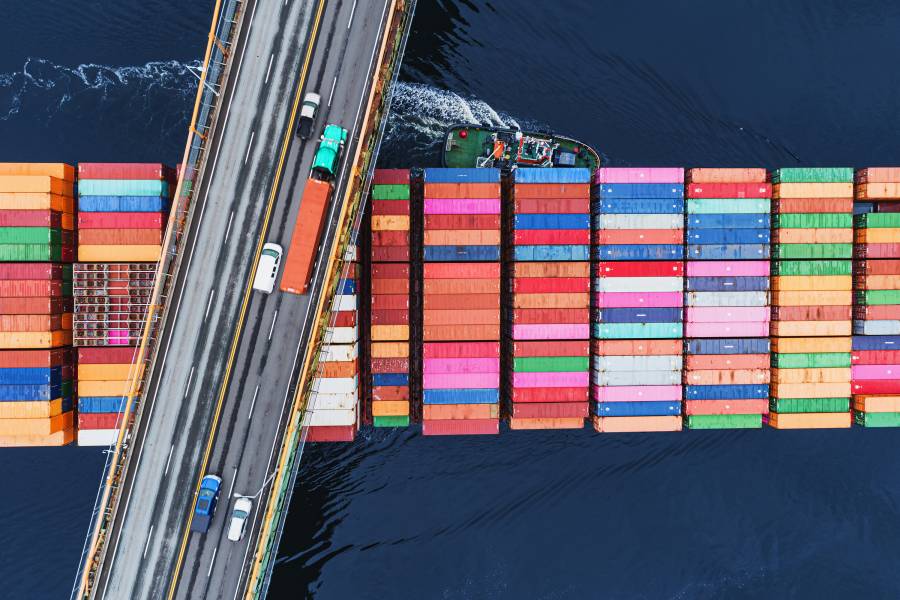Twitter is full of jokes, memes, and exasperated ramblings about ongoing supply chain issues. Shortages and delays have been happening throughout the pandemic—who can forget the scramble for toilet paper? But even now, more than a year and a half into life with COVID-19, empty shelves dot the aisles of supermarkets, drugstores, and big-box retailers. Whether we're buying groceries or shopping for holiday gifts, supply chain issues endure.

Image caption: Tinglong Dai
Tinglong Dai is a professor of operations management and business analytics at the Johns Hopkins Carey Business School. Here, he discusses what the issues actually are, when we might expect things to return to normal, and how this crisis might change the shipping industry for the better.
What do people mean when they say that we're having supply chain issues?
A supply chain is essentially the information, money, people, and resources connecting supply (manufacturers and their suppliers) and demand (the customer). When we log onto Amazon and click "order," there's a supply chain connecting the factory floor to packaging, to warehousing, to transportation, and to retailing. We rarely notice the existence of that supply chain unless something goes terribly wrong. When people talk about supply chain issues, what they mean is their Crate & Barrel furniture order has been in processing for five months or they have only two models to choose from at their local bike shop.
What is the root cause of the issues we're facing now?
In March 2020, there was a dramatic decrease in the demand for goods and services because of the pandemic. By June 2020, the demand already exceeded pre-pandemic levels for goods like laptops, fitness equipment, furniture, gardening supplies, automobiles—pretty much everything. So that caused retailers' inventory to drop to very low levels by 2021. Now the retailers are trying to catch up by placing larger, and earlier, orders than before the pandemic. That has led to a dramatic increase in shipments from Asia. That's why we're seeing a lot of cargo ships getting stuck in L.A., Long Beach, and Georgia. As a result, we do have a lot of goods that have arrived in the U.S., but they just won't move to shelves. That's the reason we're seeing a lot of supply chain issues these days. We just don't have enough people handling these shipments. So, we're having this labor shortage relative to the demand we have. This isn't so much about the global supply chain; this is really about our domestic logistics and transportation system that is being maxed out.
Also see
Do you think the push to operate the Port of Los Angeles 24/7 will make a difference?
Any Hopkins MBA student who has done the "National Cranberry" case in my operations course knows the answer is no. In the cranberry case, a stunning number of trucks had trouble unloading berries to a processing factory. Your first reaction might be to increase the unloading capacity. That option turned out to be a waste of money, because the bottleneck wasn't the unloading part; it was machines inside the factory.
As far as we know, the ports are not really the bottleneck of the supply chain. If you double the capacity at the port, that doesn't solve the shortage of truck drivers. That doesn't solve the problem of limited warehouse spaces. And that doesn't solve labor shortages retailers face either. You are treating the symptoms, not the disease. Having said that, I think it is better than doing nothing, because some parts in the supply chain have to act first. The fact that the port will be run 24/7, that gives warehouses incentive to expand their space; that gives the trucking companies the incentive to hire more workers because there will be more hours available.
How do we explain this labor shortage?
There are two ways of looking at this. First, because of this COVID-19 pandemic, millions of people lost their jobs temporarily or permanently last year. As the economy recovers, not everyone has returned to work. But that may not be the main reason for what is playing out now. What I have seen is more obvious: We simply don't have enough labor to meet the increased demand. We're seeing a 200%, 300% increase in workload, and we just don't have enough people to handle that. We already have about 3 million truck drivers. That's almost one truck driver per 100 people in the U.S.
Are there certain types of products that are most directly affected by everything that's going on?
Not all shortages are created equal. Retailers are very savvy. They're solving a prioritization problem. Facing labor shortages in transportation and warehousing, it's only natural that they prioritize high-priced items. For example, if you want to buy a TV, you'll have no problem buying a $2,000 LCD TV, but the same may not be true for $300 models. From consumers' perspective, they are facing pricier items on the shelves. That may be OK because many people are willing to try more expensive products as they spend more time at home.
So far, I've only had trouble finding my laundry soap and face wash.
You're right. The full impact of supply chain issues is yet to be felt. Retailers still have plenty of inventory. In the case of most retailing locations, we do not see many empty shelves. We see full shelves for the most part. It's just that we have less variety. Stores are trying to figure out the best way to address coming shortages. At a certain point, consumers have to accept less variety and higher prices.
How do you see the situation resolving itself, and how long do you think it might take before the supply chain resets to pre-pandemic levels of operation?
Many retailers expect the situation to be back to normal by the second quarter of 2022 at the earliest. The exact timing depends on how retailers and consumers respond to this. Are we going to settle with OK holiday gifts? Can we use that artificial Christmas tree for one more year? Are we going to accept less variety and high prices? The more adaptive and flexible people are, the sooner the situation will improve.
Is there any silver lining behind all of this? Is there any reason to believe that we might see sweeping changes that will be better for workers and retailers and the global economy?
I believe there is. This crisis shows that our supply chain doesn't have the kind of flexibility we need. Can we scale up the transportation capacity? Apparently not. I hope this supply chain crisis will prompt us to build better railway infrastructure that allows for flexible and scalable transportation capacity in uncertain times. The reason I emphasize railway infrastructure is because this is one area where the U.S. has huge potential. We have the most extensive railway network of any country, including China, Japan, and India. At the same time, we have an acute low-tech situation. Compared with countries such as South Korea, Japan, and Australia, our railway network is as dangerous as inefficient. That severely limits our rail transport capacity. Right now, our trains transport almost as many goods as trucks do. If we can increase its market share to 75% or 80%, we'll be able to significantly increase the overall flexibility of our transportation system. There are fully autonomous trains in many other countries, but not here. We like to think we are the most technologically advanced country, but we don't have such readily available technologies many other countries have. That must change.
How do you think consumers should prepare for the holiday season?
Buy local; buy American. And shop for holiday gifts as early as you can, if you really have to get that perfect Christmas gift on time. Support local businesses and domestically made products. We really need to support U.S. manufacturers and brick-and-mortar retailers if we care about the health of our supply chains.
As people worry about shortages, we will almost certainly see a lot of inventory nobody wants to have by January or February because retailers are placing such big orders from manufacturers. We should pause for a moment and think about what all this means for Earth when the entire world is crazy about supply chains.
Posted in Voices+Opinion, Politics+Society
Tagged consumer behavior, retail, supply chain, tinglong dai, holiday shopping











